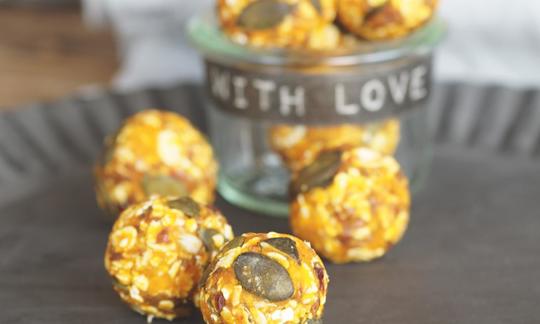Pumpkin and Oat Bites with Cranberries and Dates
vegan
Ingredients (for servings, )
| 8 ½ oz | Hokkaido pumpkins (Hokkaido pumpkins) |
| 1 tbsp | Lemon juice (raw?, organic?) (0.26 oz) |
| 1 tbsp | Carrot juice, fresh (pasteurized?, organic?) (0.20 oz) |
| 2 tbsp | Drinking water, raw (organic?) (0.40 oz) |
| 3 ½ oz | Dates, Medjool variety, pitted, raw? (organic?) |
| 1 ¾ oz | Cranberries, dried, sweetened (raw?, organic?) |
| 1 tbsp, whole | Linseed, raw, organic? (golden linseed, flax) (0.36 oz) |
| 1 ¾ oz | Oat flakes (raw?, organic?) |
| 1 ¾ oz | Rice flakes (raw? organic?) |
| 1 oz | Rice syrup (organic?) |
| 1 ¾ oz | Pumpkin seeds, dried, raw (organic?) |
| 1 dash | Cinnamon (ground, raw, organic?) (0.00 oz) |
| 1 dash | Ginger, ground (powder, raw?, organic?) (0.00 oz) |
| 1 dash | Real coriander, seeds (raw?, organic?) (0.01 oz) |
| 1 dash | Nutmeg, ground or grated (raw, organic?) (0.00 oz) |
| 1 dash | Vanilla powder (ground vanilla, organic?) (0.01 oz) |
| 1 dash | Table salt (table salt, raw?, organic?) (0.01 oz) |
Equipment
- juicer or food processor
- blender
- vegetable peeler
- stove
- citrus juicer (lemon squeezer)
- saucepan
Type of preparation
- cook
- chop or grind
- steam
- blend
- juice
- squeeze
- peel
Preparation
Peel the pumpkin, remove the seeds, and then cut the pumpkin into small cubes. Add the pumpkin cubes, lemon juice, carrot juice, and water to a small saucepan.
After cleaning the pumpkin (about 240 g), you should have about 130 grams of pumpkin flesh. Since you can eat the skin of Hokkaido pumpkin, you don’t have to peel the pumpkin before dicing.
If you are using a juicer to make fresh carrot juice, instead of throwing away the pulp you can use it to make other dishes (see Tips).
Cover the saucepan and steam on medium heat for about 10 minutes. Then purée with a fork and let cool.
While the pumpkin purée is cooking and cooling, you can continue with the next step.
Grind the dates, cranberries, and flaxseed in the food processor.
If you can source them, it is best to use unsweetened cranberries.
In a mixing bowl, combine the rolled oats, rice flakes, rice syrup, pumpkin seeds, spices, and salt.
Combine with the pumpkin purée and date mixture and mix together until the dough is smooth. Shape into small balls that are about the size of a teaspoon.
A recipe to serve six makes about 30 balls. You can, of course, make them somewhat larger or smaller.
These pumpkin and oat bites can be stored in the refrigerator for several days.
|
Nutritional Information per person
Convert per 100g
|
2000 kcal | |
|---|---|---|
| Energy | 221 kcal | 11.1% |
| Fat/Lipids | 5.8 g | 8.2% |
| Saturated Fats | 0.97 g | 4.8% |
| Carbohydrates (inc.dietary fiber) | 41 g | 15.2% |
| Sugars | 21 g | 23.4% |
| Fiber | 4.3 g | 17.4% |
| Protein/Albumin | 5.3 g | 10.5% |
| Cooking Salt (Na:31.4 mg) | 80 mg | 3.3% |
| Essential micronutrients with the highest proportions | per person | 2000 kcal | |
|---|---|---|---|
| Min | Manganese, Mn | 1.3 mg | 64.0% |
| Prot | Tryptophan (Trp, W) | 0.09 g | 35.0% |
| Min | Copper, Cu | 0.30 mg | 30.0% |
| Elem | Phosphorus, P | 197 mg | 28.0% |
| Elem | Magnesium, Mg | 93 mg | 25.0% |
| Vit | Vitamin B1 (Thiamine) | 0.24 mg | 22.0% |
| Elem | Potassium, K | 418 mg | 21.0% |
| Fat | Alpha-Linolenic acid; ALA; 18:3 omega-3 | 0.43 g | 21.0% |
| Fat | Linoleic acid; LA; 18:2 omega-6 | 2.1 g | 21.0% |
| Prot | Threonine (Thr, T, irreversibly transaminated) | 0.18 g | 19.0% |
Detailed Nutritional Information per Person for this Recipe
The majority of the nutritional information comes from the USDA (US Department of Agriculture). This means that the information for natural products is often incomplete or only given within broader categories, whereas in most cases products made from these have more complete information displayed.
If we take flaxseed, for example, the important essential amino acid ALA (omega-3) is only included in an overarching category whereas for flaxseed oil ALA is listed specifically. In time, we will be able to change this, but it will require a lot of work. An “i” appears behind ingredients that have been adjusted and an explanation appears when you hover over this symbol.
For Erb Muesli, the original calculations resulted in 48 % of the daily requirement of ALA — but with the correction, we see that the muesli actually covers >100 % of the necessary recommendation for the omega-3 fatty acid ALA. Our goal is to eventually be able to compare the nutritional value of our recipes with those that are used in conventional western lifestyles.
| Essential fatty acids | per person | 2000 kcal |
|---|---|---|
| Alpha-Linolenic acid; ALA; 18:3 omega-3 | 0.43 g | 21.0% |
| Linoleic acid; LA; 18:2 omega-6 | 2.1 g | 21.0% |
| Essential amino acids | per person | 2000 kcal |
|---|---|---|
| Tryptophan (Trp, W) | 0.09 g | 35.0% |
| Threonine (Thr, T, irreversibly transaminated) | 0.18 g | 19.0% |
| Isoleucine (Ile, I) | 0.22 g | 18.0% |
| Phenylalanine (Phe, F) | 0.28 g | 18.0% |
| Leucine (Leu, L) | 0.40 g | 17.0% |
| Valin (Val, V) | 0.26 g | 16.0% |
| Lysine (Lys, K, irreversibly transaminated) | 0.22 g | 12.0% |
| Methionine (Met, M) | 0.09 g | 10.0% |
| Vitamins | per person | 2000 kcal |
|---|---|---|
| Vitamin B1 (Thiamine) | 0.24 mg | 22.0% |
| Vitamin B9, B11 (Folate, as the active form of folic acid) | 29 µg | 14.0% |
| Vitamin B6 (pyridoxine) | 0.15 mg | 11.0% |
| Vitamin K | 7.8 µg | 10.0% |
| Vitamin A, as RAE | 72 µg | 9.0% |
| Vitamin B7 (Biotin, ex vitamin H) | 4.5 µg | 9.0% |
| Vitamin B3 (Niacin) | 1.3 mg | 8.0% |
| Vitamin B5 (Pantothenic acid) | 0.50 mg | 8.0% |
| Vitamin C (ascorbic acid) | 5.7 mg | 7.0% |
| Vitamin B2 (Riboflavin) | 0.07 mg | 5.0% |
| Vitamin E, as a-TEs | 0.59 mg | 5.0% |
| Essential macroelements (macronutrients) | per person | 2000 kcal |
|---|---|---|
| Phosphorus, P | 197 mg | 28.0% |
| Magnesium, Mg | 93 mg | 25.0% |
| Potassium, K | 418 mg | 21.0% |
| Calcium, Ca | 39 mg | 5.0% |
| Sodium, Na | 31 mg | 4.0% |
| Essential trace elements (micronutrients) | per person | 2000 kcal |
|---|---|---|
| Manganese, Mn | 1.3 mg | 64.0% |
| Copper, Cu | 0.30 mg | 30.0% |
| Iron, Fe | 2.1 mg | 15.0% |
| Zinc, Zn | 1.5 mg | 15.0% |
| Selenium, Se | 5.1 µg | 9.0% |
| Fluorine, F | 15 µg | < 0.1% |
| Iod, I (Jod, J) | 0.42 µg | < 0.1% |
"Healthy Baking" contains a variety of, mainly sweet, baking ideas that are not only healthy, but also culinary appealing and easy to prepare
Since this book is written in German, a description is omitted here. If you are interested, please switch to German in the menu.
These delicious pumpkin and oat bites with cranberries and dates are an easy-to-prepare dessert that are also nice as a snack.
Hokkaido pumpkins (red curry squash): Unlike most other pumpkins, the skin of a small Hokkaido pumpkin (1–2 kg) can be eaten and doesn’t need to be peeled. This is because it softens when cooked. Hokkaido pumpkin has a firm consistency, is low in fiber, and has a slightly nutty flavor. The orange color comes from the large amount of beta-carotene it contains, which our body can convert into vitamin A. It also has large amounts of vitamin B1, B2, and B6; vitamins C and E; as well as folic acid, magnesium, iron, and phosphorus.
Pumpkin seeds: Pumpkin seeds are rich in protein, fiber, and micronutrients
Medjool dates: Compared to other types of dates, the Medjool variety is known for its large size, soft texture, and unique fruity flavor. Dates are quite sweet and are classified as a fruit. They are rich in vitamins A, B, and C as well as the minerals potassium, calcium, and magnesium. In addition, they contain more fiber than whole grain bread. Dried dates can be stored for up to a year. If they are stored longer, then they dry out and begin to crystalize; they also become sweeter and develop a “brittle-soft” texture. Dried dates come in at just under 100 on the glycemic index and should therefore be consumed in moderate amounts. However, compared to sugar and sweets containing sugar, they are certainly the healthier alternative.
Rice syrup: Rice syrup is obtained by fermenting rice flour. During this process, starch-degrading enzymes convert the rice starch mainly into maltose. Rice syrup is a viscous, brown syrup that can be used as a general sweetener and for baking. It has a mild, butterscotch flavor. Two types of rice syrup are available commercially: a maltose rice syrup that has been produced industrially and a healthier rice syrup that has been produced according to traditional practice.
Ground vanilla is not vanilla sugar: Although these two terms are sometimes used incorrectly as synonyms, they are two very different products. Ground vanilla, also called vanilla powder, is obtained by grinding vanilla bean pods. Vanilla sugar, however, is a mixture of vanilla and natural vanilla flavor or vanilla extract. Vanilla bean pods are not raw.
Using the carrot pulp: After you juice the carrots, instead of throwing away the pulp you can use it to make other dishes such as carrot pesto. To do so, steam the carrot pulp with a little water, garlic, and chili pepper. Add a little oil and then purée. Season to taste with salt and pepper.
Storage: The author Stina Spiegelberg states that the pumpkin and oat bites can be stored in the refrigerator for several days.
Tip from the author: Toast the pumpkin seeds in a skillet before using in the recipe. This will make the flavor more pronounced.




